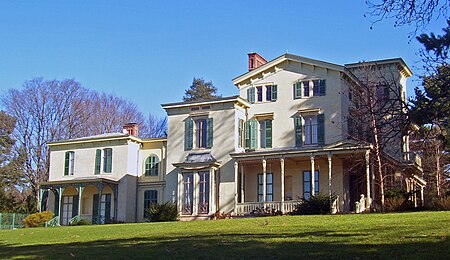Nuits (Irvington, New York)
1852 establishments in New York (state)Houses completed in 1852Houses in Westchester County, New YorkHouses on the National Register of Historic Places in New York (state)Hudson River ... and 3 more
Irvington, New YorkItalianate architecture in New York (state)National Register of Historic Places in Westchester County, New York

Nuits, also known as the Cottenet–Brown House, is an Italian villa-style house located in the Ardsley-on-Hudson section of the village of Irvington, New York, United States. It is a stone Italian villa-style house built in the mid-19th century. In 1977 it was listed on the National Register of Historic Places. It is the only surviving example of the early residential architecture of Detlef Lienau. Built for Francis Cottenet, a wealthy New York merchant, it was later owned and renovated by Cyrus West Field, John Jacob Astor III and Manhattan College. It remains a private residence.
Excerpt from the Wikipedia article Nuits (Irvington, New York) (License: CC BY-SA 3.0, Authors, Images).Nuits (Irvington, New York)
Clifton Place,
Geographical coordinates (GPS) Address Nearby Places Show on map
Geographical coordinates (GPS)
| Latitude | Longitude |
|---|---|
| N 41.024166666667 ° | E -73.873611111111 ° |
Address
Clifton Place 1
10533
New York, United States
Open on Google Maps






